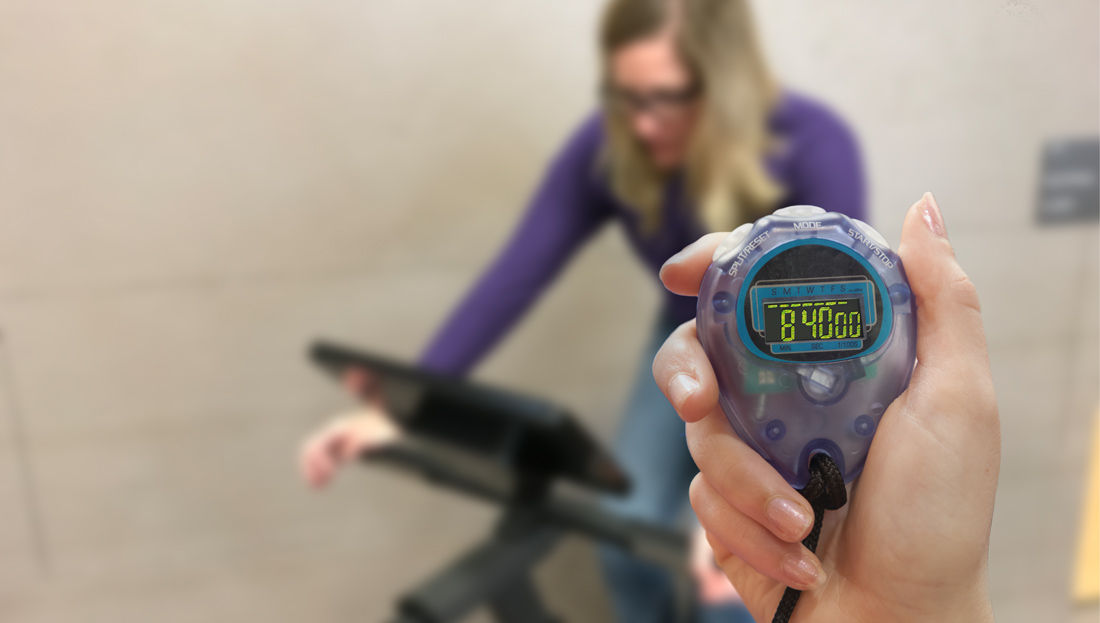
By Lance C. Dalleck, Ph.D., Tom Cuddy, M.Sc., and Brandon Krattenmaker, B.S., with Daniel J. Green
Here at the American Council on Exercise, we have been writing about high-intensity interval training (HIIT) for more than a decade, and ACE-sponsored research has found HIIT to be a time-efficient way to achieve meaningful health and fitness benefits.
HIIT involves alternating between brief bouts of high-intensity exercise lasting 30 seconds to five minutes with either rest or lower-intensity work during an exercise session. This type of training allows for shorter workouts but provides results that are equal to, and often better than, traditional moderate-intensity steady-state training. Importantly, HIIT is versatile enough to be used with clinical populations as well as to create resistance-training programs.
CAR.O.L (CARdiovascular Optimization Logic), formerly known as High Octane Ride, is a stationary bike that incorporates a modified form of HIIT called reduced-exertion high-intensity training (REHIT). REHIT shortens the traditional HIIT workout by using fewer and shorter sprints, though those sprints are at a supra-maximal intensity. According to the manufacturer’s website, the bike uses a form of artificial intelligence that controls the resistance and timing on the rides and adjusts the resistance to each individual’s level of both power and fatigue, helping him or her get progressively fitter and stronger.
The manufacturer claims that CAR.O.L provides the most effective HIIT workout, which consists of a two-minute warm-up, a 20-second sprint, a three-minute recovery, a second 20-second sprint and finally a three-minute cool-down. Total workout time: 8 minutes and 40 seconds.
But is that really enough to be effective? To find out, ACE enlisted the help of Lance Dalleck, PhD, and his team of researchers in the High Altitude Exercise Physiology Program at Western State Colorado University to find out. The researchers placed the bike in a workplace setting and had participants use the bike as described below over a period of eight weeks.
The purpose of this research was twofold: (1) to quantify the acute cardiovascular and metabolic responses to REHIT and (2) to determine the effectiveness of an eight-week REHIT program at improving cardiorespiratory fitness and positively modifying cardiometabolic health in a workplace environment.
The Study
The research team recruited 16 men and 16 women to participate in the study, all of whom were low-to-moderate risk and physically inactive. None of the participants had any evidence of cardiovascular, pulmonary and/or metabolic disease.
To quantify the acute cardiovascular and metabolic responses to the CAR.O.L, participants wore heart-rate monitors throughout two sessions (one “intense ride” and one “fat burn ride;” see below), which took place during weeks 4 and 5 of the eight-week program.
To investigate participants’ chronic responses, the researchers randomly divided them into one of two training groups:
- One group completed an eight-week REHIT program consisting of a combination of the intense and fat burn ride options performed on the CAR.O.L stationary bike.
- The other group completed a standardized moderate-intensity continuous training (MICT) program consisting of five days per week of 30-minute aerobic exercise at 50 to 65% of heart-rate reserve (HRR).
In addition to the 8-minute and 40-second ride described earlier (called the “intense ride”), other ride options are available, including two “fat burn rides,” each of which includes a two-minute warm-up and a three-minute cool-down:
- 15 minutes total: 30 x 8-second sprints with 12 seconds of rest in between
- 20 minutes total: 60 x 8-second sprints with 12 seconds of rest in between
Importantly, the CAR.O.L bike adjusts from workout to workout, individualizing the program and coaching the exerciser to improve his or her performance over previous workouts.
Before and after the eight-week program, the researchers collected anthropometric measurements (waist circumference and weight), fasting blood lipid and blood glucose, and resting blood pressure. In addition, all participants completed a maximal exercise test on a cycle ergometer to determine their maximal heart rate and maximal cardiorespiratory fitness. The full program is presented in Figure 1.
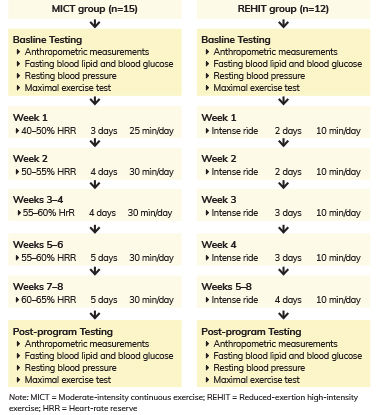
Figure 1
Experimental flow diagram and week-to-week exercise programming for the days and times of training
The Results
Acute Cardiovascular and Metabolic Responses to REHIT
The acute cardiovascular and metabolic responses to the REHIT sessions are presented in Table 1. Peak heart rate for the REHIT workouts was 168 bpm, which corresponded to 94% of HRR. Peak metabolic equivalent (METs) was 8.8, which equated to a 93% of oxygen uptake reserve (VO2reserve). The peak systolic blood pressure (SBP) was 218 mmHg, while the peak diastolic blood pressure (DBP) was 98 mmHg.

Chronic Responses to Eight Weeks of REHIT versus MICT
The physical and physiological characteristics of the participants in both groups at baseline and after the eight-week program are presented in Table 2. Five of the participants were unable to complete the program due to either illness or personal reasons. While dropout was higher in the REHIT group, this was not due to injury or anything else related to the program itself. Overall, adherence to the program was excellent, with the REHIT group completing 89% of the workouts and the MICT group completing 88%.
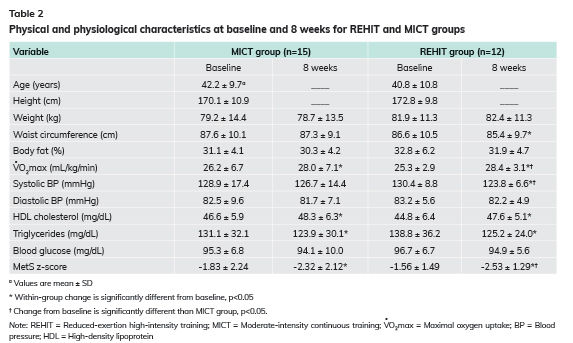
After the eight-week program, the REHIT group saw more favorable results than the MICT group in the following measures: maximal oxygen uptake (VO2max), SBP, waist circumference, and MetS score. Both groups saw significant improvements in VO2max, high-density lipoprotein cholesterol, triglycerides and MetS z-score; however, only the REHIT group showed significant reductions in SBP and waist circumference.
MetS z-score and Responders versus Non-responders
Traditionally, researchers looking into training responsiveness have used VO2max to quantify improvements in cardiorespiratory fitness, which provides a very narrow view. In contrast, the MetS z-score combines a number of cardiometabolic risk factor values into a single score, including blood pressure, circumference measures, blood glucose, high-density lipoprotein and triglycerides. The primary benefits for inclusion of a continuous MetS z-score are twofold: (1) it acknowledges that there is a continuum to cardiometabolic risk within each individual and (2) it provides a more sensitive tool for assessing individualized training responsiveness following an exercise intervention.
“By broadening the assessment of training responsiveness using the MetS z-score, researchers are better able to capture the true benefits of an exercise program,” explains Dr. Dalleck.
Think about it this way: If you were working with a client on a long-term exercise program, would you be better served by monitoring progress using a single value such as body weight or a combination of several different measures of cardiorespiratory fitness, muscular fitness and even quality of life?
In this study, the REHIT group saw a positive improvement in the MetS z-score in 75% of the individuals, while the MICT group saw a positive improvement in only 47% of individuals (Figure 2). This is a significant difference and reflects the fact that nine out of 12 members of the REHIT group experienced significant improvements in their overall health, while only seven out 15 members of the MICT group saw similar improvements.
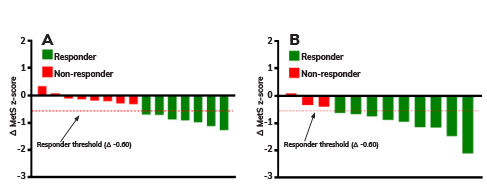
Figure 2
Inter-individual variability in the MetS z-score responses to exercise training in the (A) MICT group and the (B) REHIT group
The Bottom Line
Were the REHIT workouts more potent and more time-efficient than the MICT workouts? In a word, yes.
As described by the research team, the main finding of this study is that the eight-week REHIT CAR.O.L program elicited more potent and time-efficient improvements in cardiorespiratory fitness (i.e., VO2max) and cardiometabolic health when compared to traditional MICT. In fact, the REHIT group saw a nearly twofold greater improvement in VO2max (12.3%) relative to the MICT group (6.9%). In addition, the reductions in SBP in the REHIT group were three times what they were in the MICT group.
Dr. Dalleck reminds us that “lack of time” is the most often cited reason for not exercising regularly. The short duration of these workouts cannot be emphasized enough—8 minutes and 40 seconds.
These findings provide health coaches and exercise professionals with another means of assisting clients as they work to achieve their health and fitness goals, and ultimately helps ACE accomplish its mission to get more people moving.
How to Purchase the CAR.O.L Bike
 The CAR.O.L stationary bike costs $2,995, and the company offers several financing options. In addition, there is a $12/month subscription fee for the software license, which includes a personalized cloud-based account that tracks each rider’s progress, delivers each ride at the appropriate resistance and maintains a leaderboard to create a sense of competition and community at home, in the gym or in the workplace.
The CAR.O.L stationary bike costs $2,995, and the company offers several financing options. In addition, there is a $12/month subscription fee for the software license, which includes a personalized cloud-based account that tracks each rider’s progress, delivers each ride at the appropriate resistance and maintains a leaderboard to create a sense of competition and community at home, in the gym or in the workplace.
While CAR.O.L offers a slightly different fee structure than Peloton, overall the pricing is comparable. You can learn more at https://shop.carolfitai.com/usa/.





 by
by 

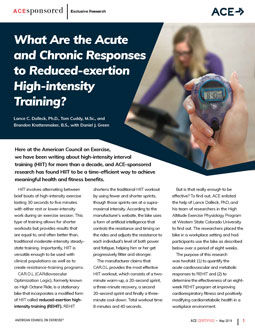




 The CAR.O.L stationary bike costs $2,995, and the company offers several financing options. In addition, there is a $12/month subscription fee for the software license, which includes a personalized cloud-based account that tracks each rider’s progress, delivers each ride at the appropriate resistance and maintains a leaderboard to create a sense of competition and community at home, in the gym or in the workplace.
The CAR.O.L stationary bike costs $2,995, and the company offers several financing options. In addition, there is a $12/month subscription fee for the software license, which includes a personalized cloud-based account that tracks each rider’s progress, delivers each ride at the appropriate resistance and maintains a leaderboard to create a sense of competition and community at home, in the gym or in the workplace.
